There’s something magical about falling asleep to the sound of waves and waking up to the sunrise over the ocean. Beach camping offers a totally different experience from your typical forest or mountain campsite.
There is nothing quite like midnight walks on the beach, fresh sea breezes, and unobstructed views of the sea and stars.
However, these incredible rewards also come with challenges, and you’ll need to think differently when camping on the beach. Sand gets everywhere, tides can change dramatically throughout the day, and weather patterns are often different.
To have a great trip, I’ve learned that success comes down to several key factors. If you follow these tips for camping on the beach, you’ll have an amazing time!
Let’s take a look at my beach camping guide …
No time right now to read these beach camping tips and tricks? Pin It and save it for later:
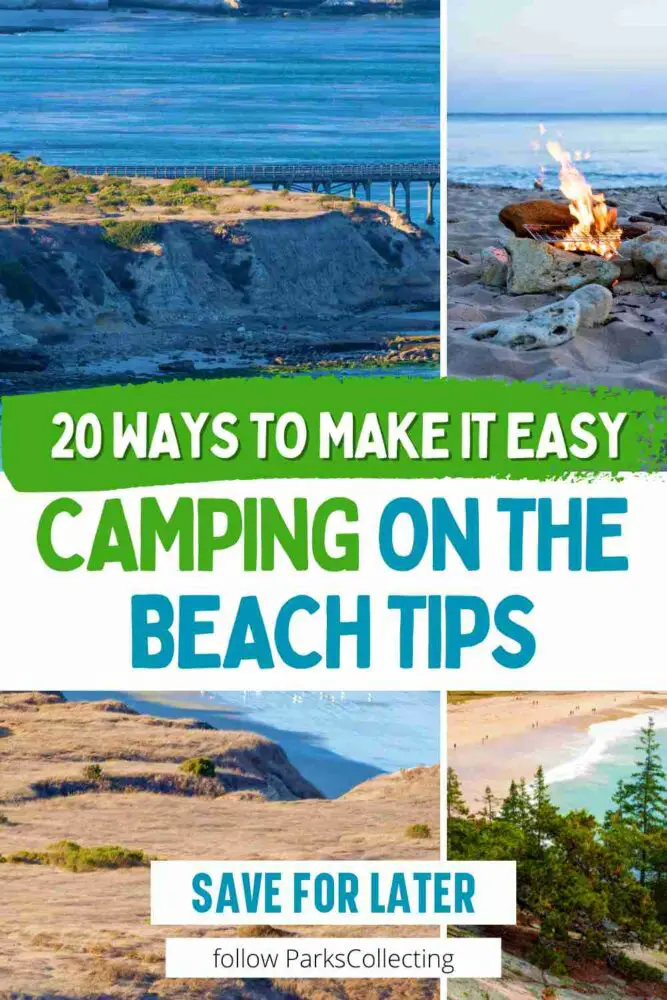
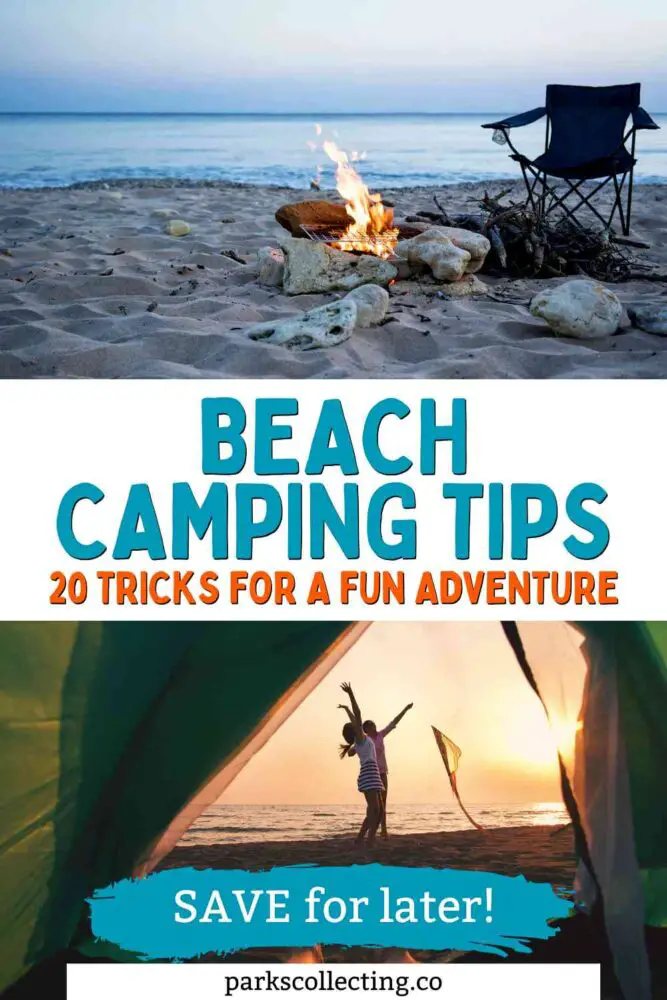
🛏️FIND A HOTEL: Search now
🚘FIND THE CHEAPEST CAR RENTAL: Search Discover Cars for the best deals
✈️FIND THE CHEAPEST FLIGHTS: Search Skyscanner for the best deals
🧳GET TRAVEL INSURANCE: Get insured with Travelex before you go
📱TAKE AN AUDIO TOUR: Buy an audio tour now
Subscribe to daily national parks planning tips, travel inspiration and trip ideas and I’ll send you a free PDF of this Guide:
20 Beach Camping Tips for First Timers
Table of Contents
1. Check that camping is allowed
Not every beach allows camping, so start by finding spots that welcome overnight stays. Make sure that you’re allowed to camp at the beach that you’re planning to go to. Many state parks and national seashores offer designated camping areas with basic facilities.
2. Check the rules before you go
Some beaches require permits, while others have specific regulations about campfires, alcohol, or vehicle access. You’ll want to know what’s allowed and what’s not before setting up camp.
3. Check the tides
Check tide charts and always double check the weather forecast in case bad weather is coming, which might raise the water line.
4. Choose a good location

When you get to the beach, choose your site carefully. First up, it has to be above the high tide line. In addition to checking the tide charts, you can usually see a line of seaweed, shells or driftwood that indicates the high tide line. Set up your camp at least 50 feet beyond this point.
It’s actually better to camp in amongst vegetation on the edge of the sandy beach rather than the beach itself. This will provide some protection from the wind and rain, give you something to hang a clothes line on, and give you more privacy. However, don’t go too far from the beach. Sea breezes tend to help keep bugs away.
Also, avoid the dunes. Some beaches have sand dunes at their edge. This is a fragile environment and should be avoided if at all possible.
Always camp in designated areas to preserve the local environment and keep other beachgoers happy.
Level out your camping spot before pitching the tent. I like to smooth the sand with my feet, removing any shells or lumps that could make sleeping uncomfortable. Face your tent door away from the ocean – this cuts down on sand blowing inside when the wind picks up.
5. Know when to go
Timing matter. Summer brings crowds and bugs, while spring and fall often offer perfect camping weather. Weekdays tend to be less busy than weekends. If you’re heading to popular spots like Padre Island National Seashore, try to arrive early to snag the best spots.
6. Think about amenities
Some beaches have bathrooms and showers nearby, while others are completely primitive. If this is your first time, starting at a spot with facilities might make your first experience more comfortable.
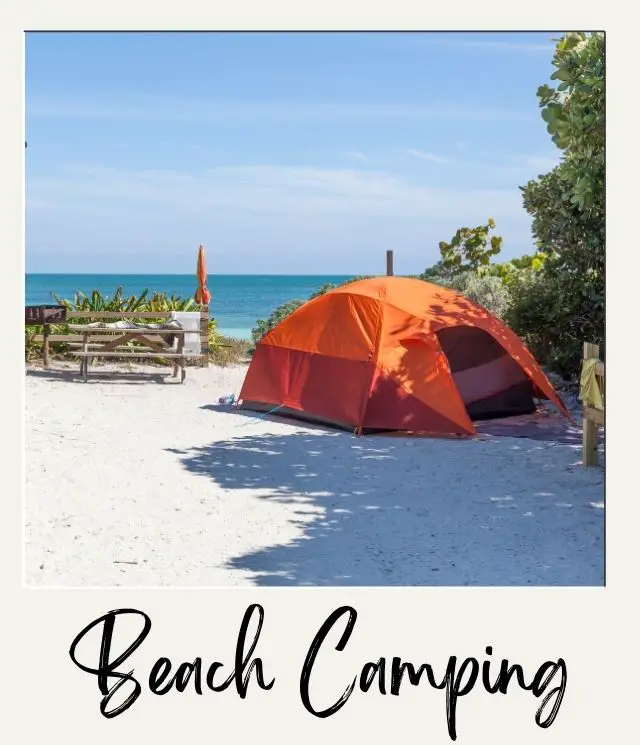
7. Know where you can get fresh water
(or bring enough for your whole trip)
Unless you’re at a dedicate campground, you probably won’t have easy access to running water. You will either need to know where your nearest source of drinkable water is or take enough with you for the whole trip.
Take more water than you think you’ll need. You’ll be in the sun a lot, and staying hydrated is especially important.
8. Choose the right shelter
There are a few options to choose from, depending on the beach, the climate, season, etc. You could go completely tentless and sleep under the stars or go with a shelter like a tarp. However, often the best option is to go with a beach tent.
Your tent is your home at the beach, so pick one with lots of mesh panels for airflow. Use reflective markers or glow sticks to mark your tent lines at night. It’s super easy to trip over guy lines when you’re walking back from watching the sunset!
A pop-up canopy gives you shaded space for cooking and hanging out – just make sure it’s really well anchored.
➡️ Find the best tent for Beach Camping
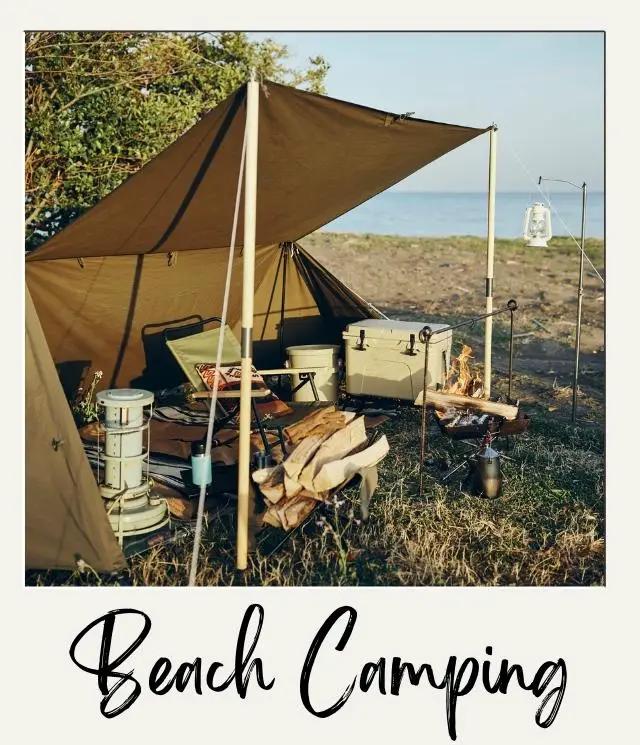
Also make sure you have a way to hold it down. Regular tent stakes won’t work in sand – grab some specialty sand stakes or bring empty bags to fill with sand as anchors. I’ve found that MSR Cyclone stakes or Orange Screw stakes work really well for keeping everything in place when those ocean breezes pick up. Some folks use 5-inch squares of plywood with guy lines attached.
➡️ Get some sand stakes for your tent
9. Have sun protection
Sun protection is no joke at the beach. The rays bounce off both water and sand, so pack plenty of sunscreen, hats with neck coverage, and a sturdy beach umbrella. Make sure your umbrella has an auger-style base – it’ll stay put better in the sand.
➡️ Get reef-safe sunscreen
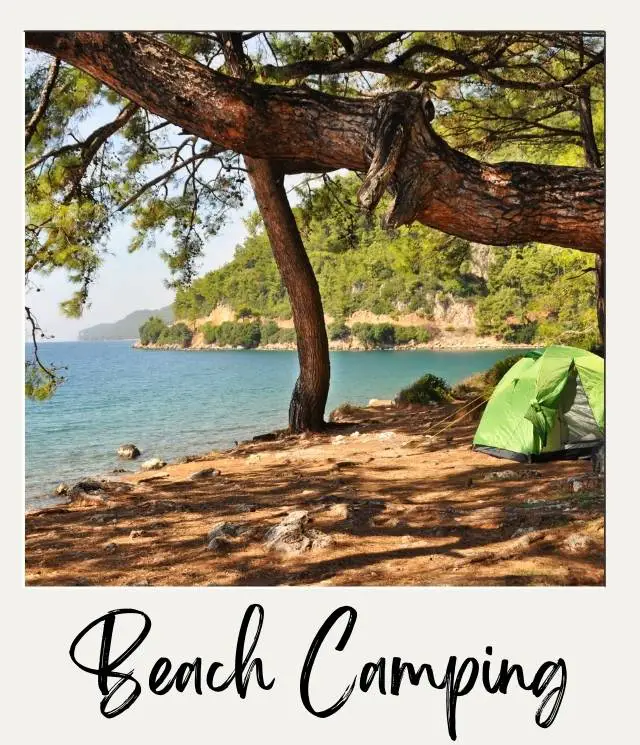
10. Choose the right sleeping gear
Have a lightweight sleeping bag. Having extra blankets in case you need them gives you the most flexibility. But you need to decide what makes the most sense for your own trip.
➡️ Check my Beach Camping Packing List for all you need
11. Build a campfire
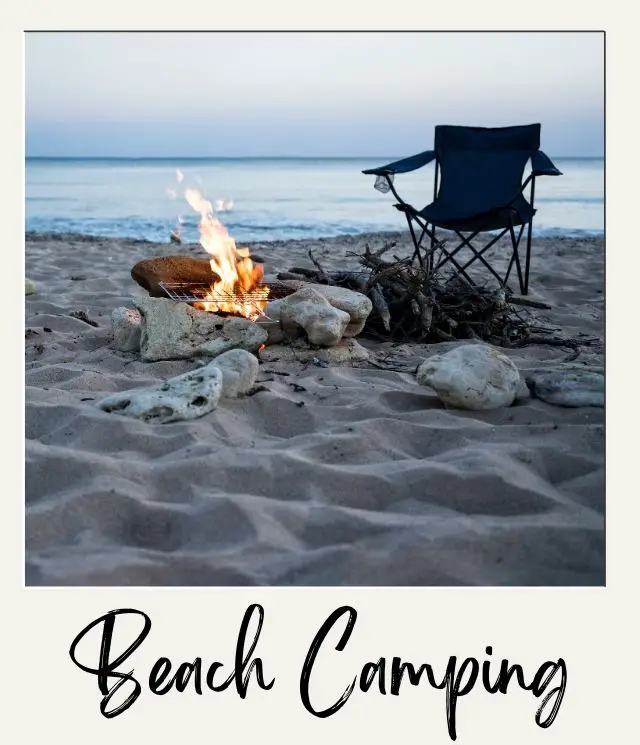
Always check that open fires are allowed. Fires can be banned if there is a high-danger period. If fires are allowed, you can either dig a hole to create a fire pit or take a portable fire pit. You can also bring a portable stove or grill if fires are allowed. A simple cookie cooling rack can work as a makeshift grill.
If you are going to cook over the fire, let the fire burn down and cook over the embers.
At the end of the night, throw sand over the embers so that the fire is completely out before you go to sleep.
12. Set up your campsite kitchen right
I recommend setting up your ‘kitchen’ away from where you sleep. Sand will get in your food no matter what but cooking upwind of your tent helps.
A small folding table keeps your stove and prep area off the ground. Those plastic boot trays from the hardware store make perfect sand-free surfaces for your cooler and supplies.
Pack food in sorted ziplock bags to keep the sand out – trust me, sandy granola isn’t fun! A 5-gallon bucket works great for food storage and doubles as a dry seat.
13. Don’t leave things outside
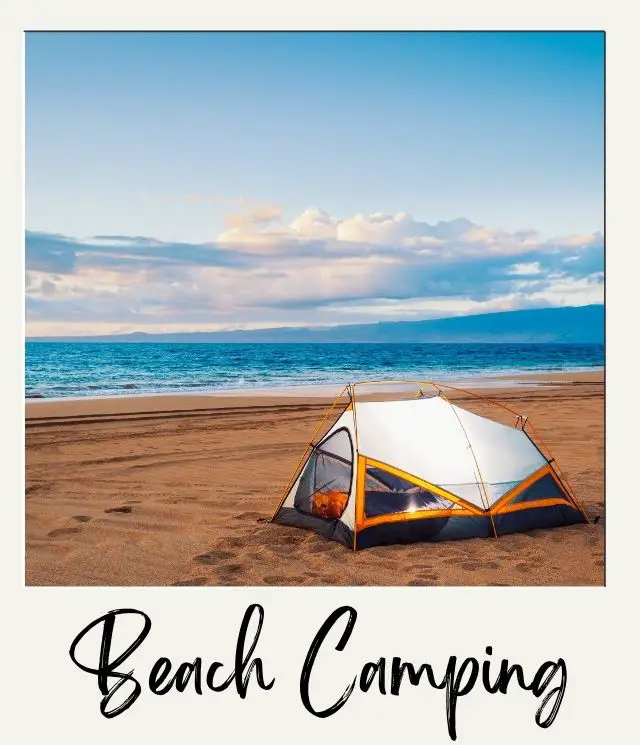
Weather at the beach can be changeable and it can rain unexpectedly overnight. So always set up a rain fly over your tent (or be prepared to dash inside if you’re sleeping under the stars) and put everything under cover. Always pack away food so it’s safe from critters.
14. Keep the sand out

Sand can get everywhere and managing sand is a constant battle. Which is why I recommend a ground tarp.
➡️ Get a ground tarp here
It helps to create a sand-free zone around your tent using artificial turf or mesh mats outside your tent helps catch loose sand before it gets inside.
Also make sure you brush off your feet before entering your tent or walking on a tarp or mat. I like to place a shallow pan of water near the tent entrance for rinsing feet. This simple step saves tons of cleanup time later.
Baby powder is amazing for getting sand off your skin, and a small hand broom with dustpan is perfect for keeping your tent clean. An option is to set up a foot-washing station using a shallow pan of water near your tent entrance.
15. Practice safety
If you’re going boating, or even if you’re not, but the water is a bit rough or you don’t swim that well, wear a life jacket.
Always keep an eye on the water – waves can sneak up on you faster than you’d think. Learn to spot rip currents by looking for breaks in the wave patterns or areas where the water looks muddier. If you get caught in one, swim parallel to the shore until you’re free from the current.
If there isn’t a lifeguard on duty, designate your own lifeguard so someone stays on the beach keeping an eye on everyone.
Never swim alone and stick to areas where you can touch the bottom.
The ocean’s very different at night, so save your swimming for daylight hours. Keep a flashlight handy for nighttime beach walks – those waves that look so pretty can be dangerous in the dark.
The weather changes quickly on the beach. Keep your phone charged and download a weather app that shows marine forecasts. If you hear thunder, pack up and head inland – being the tallest thing on an open beach during a storm isn’t smart!
16. Leave No Trace!
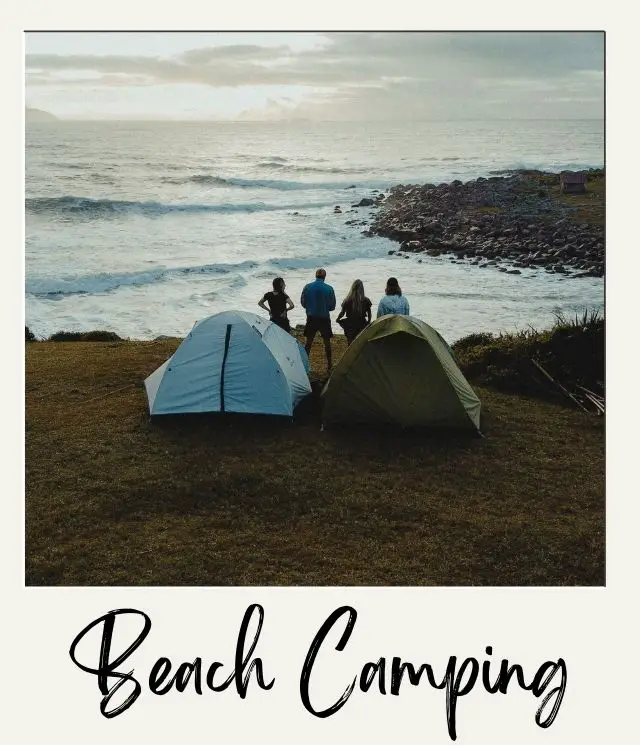
Protect the beach environment while you’re there. Pack out everything you bring in, including those tiny bits of trash that washing up. Keep food sealed tight – seagulls and raccoons love raiding campsites. And watch where you walk – many beaches have protected areas for nesting birds and turtles.
Write down the address of your camping spot and numbers for the nearest ranger station or emergency services. Cell service can be spotty, so don’t count on being able to look things up if something goes wrong.
17. Have a first aid kit
Keep a basic first aid kit handy. Include stuff for cuts (those shells are sharp!), jellyfish stings, and sunburn.
Before your trip, check what medical help is nearby. Some beaches are really remote – you might be hours from the closest hospital. Knowing this ahead of time helps you make better decisions about what risks to take.
➡️ Get a first aid kit
18. Start simple
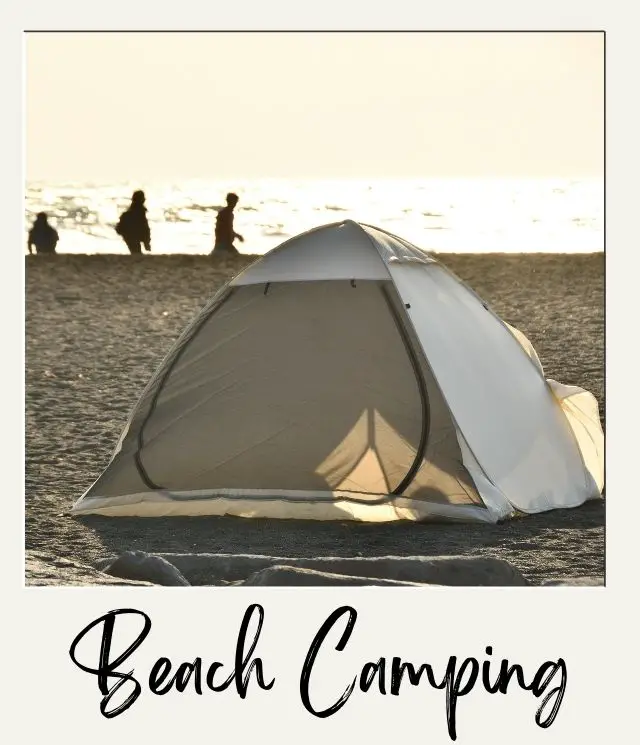
If this is your first time beach camping, starting with a short trip is the way to go. One or two nights lets you test the waters (literally!) without getting overwhelmed. Beach camping throws different challenges at you than forest camping – the wind’s stronger, the ground’s less stable, and yes, sand gets everywhere.
19. Pack smart
Quick-dry clothes are your best friend – cotton stays wet forever in the salty air. I learned this the hard way after a weekend of damp t-shirts!
Pack extra warm layers for night since temperatures can drop dramatically when the sun sets. And don’t forget a headlamp – those midnight beach walks are worth it!
Pack twice as many towels as you think you need. One set for swimming, one for drying off, and extras for wiping down gear.
➡️ Download my Complete Beach Camping Packing List
20. Don’t forget basic beach etiquette
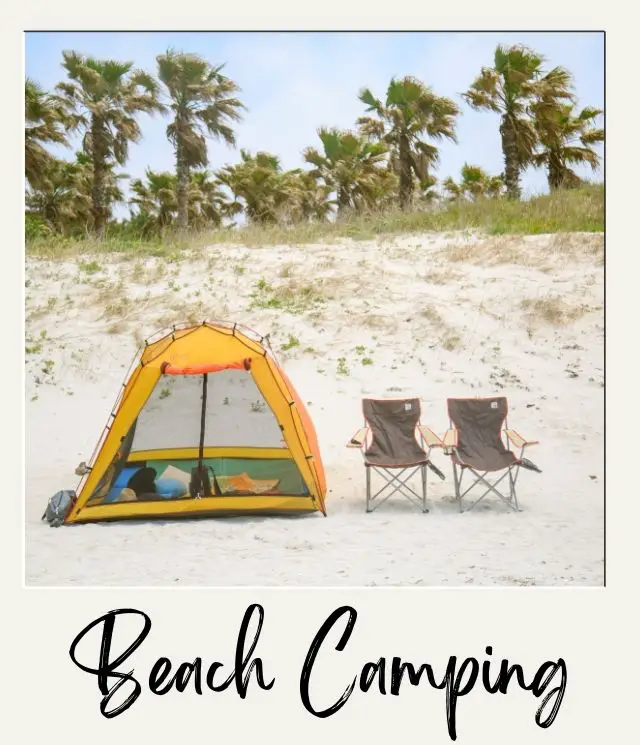
Keep noise down after dark – sound carries far over water. Seal up food tight – seagulls are crafty! Pack out everything you bring in. Leave the beach better than you found it, and you’ll have an awesome first trip!
Final Thoughts on Tips for Camping at the Beach
I hope these beach tent camping tips are helpful.
The difference between a good beach camping trip and a fantastic one often comes down to mindset. Expect the sand, plan for the wind, and remember that Mother Nature calls the shots when you’re camping oceanside. Those minor inconveniences fade away when you’re watching the sun sink into the ocean from your campsite.
I can tell you that no two beach camping experiences are the same. But they all share one thing – they’ll change how you think about camping forever. So grab those sand stakes, pack your sunscreen, and get ready for an adventure that’ll have you hooked on coastal camping.
Do you have any other camping on the beach tips? Join my private Facebook group National Parks Collectors and comment and let me know (you can also pick up extra planning tips, share your photos and stories with other national park lovers and more).
Subscribe to daily national parks planning tips, travel inspiration and trip ideas and I’ll send you a free PDF of this Guide:
20 Beach Camping Tips for First Timers
If you liked these camping at the beach tips, Pin It to your Camping board!


💡 Are you just starting to think about taking a National Parks trip? Get Inspiration
‼️ Do you need tips and additional information? Read a selection of tips for visiting US national parks
💻 Are you starting to plan a trip to a national park? Read my free guides
📋 Do you need an itinerary? Buy a detailed itinerary for your park
💲 Are you ready to book your trip? Use these Planning and Booking Resources
📖 Do you want to read a book about US national parks? Check out my Recommended Reading Lists
About the Author

James Ian is a national park, camping and hiking expert.
He has dedicated his life to travel, visiting more than 80 countries, all 7 continents and most of the national parks in the United States. With over 35 years experience in the travel industry, James has worked on cruise ships, at resorts and hotels, and as a travel planner who’s helped hundreds of people plan successful trips to US national parks.
Based on his experience visiting our national parks multiple times, in-depth research and expertise as a travel planner, James has published detailed itineraries for many of the major national parks in the US. These itineraries, as well as in-depth park guides, and other resources will help you have your own incredible trip to US national parks without stress and hassle.
As a national park expert, James has contributed to many publications, including USA Today, Newsweek, Time Business News, Savoteur, Best Trip, and Wired.
I’m a member of the Amazon Services LLC Associates Program. As an Amazon Associate I earn from qualifying purchases.
